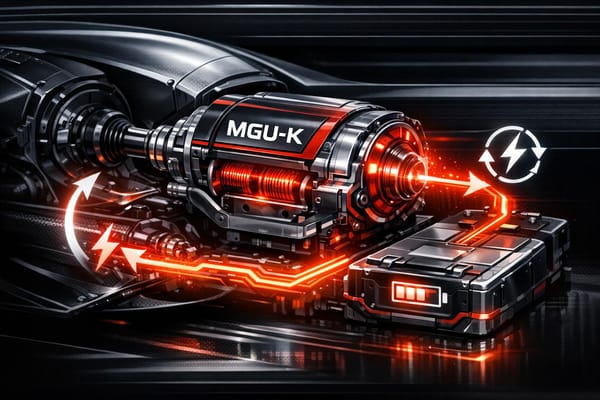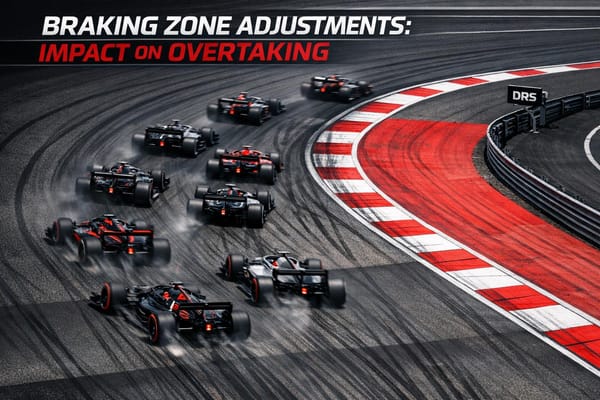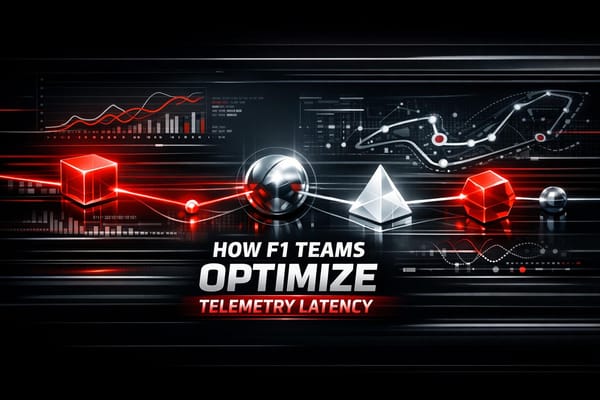AR vs. VR: Which Drives F1 Broadcasting Innovation?
Explore how AR and VR are revolutionizing Formula One broadcasting, enhancing viewer engagement and creating immersive experiences.
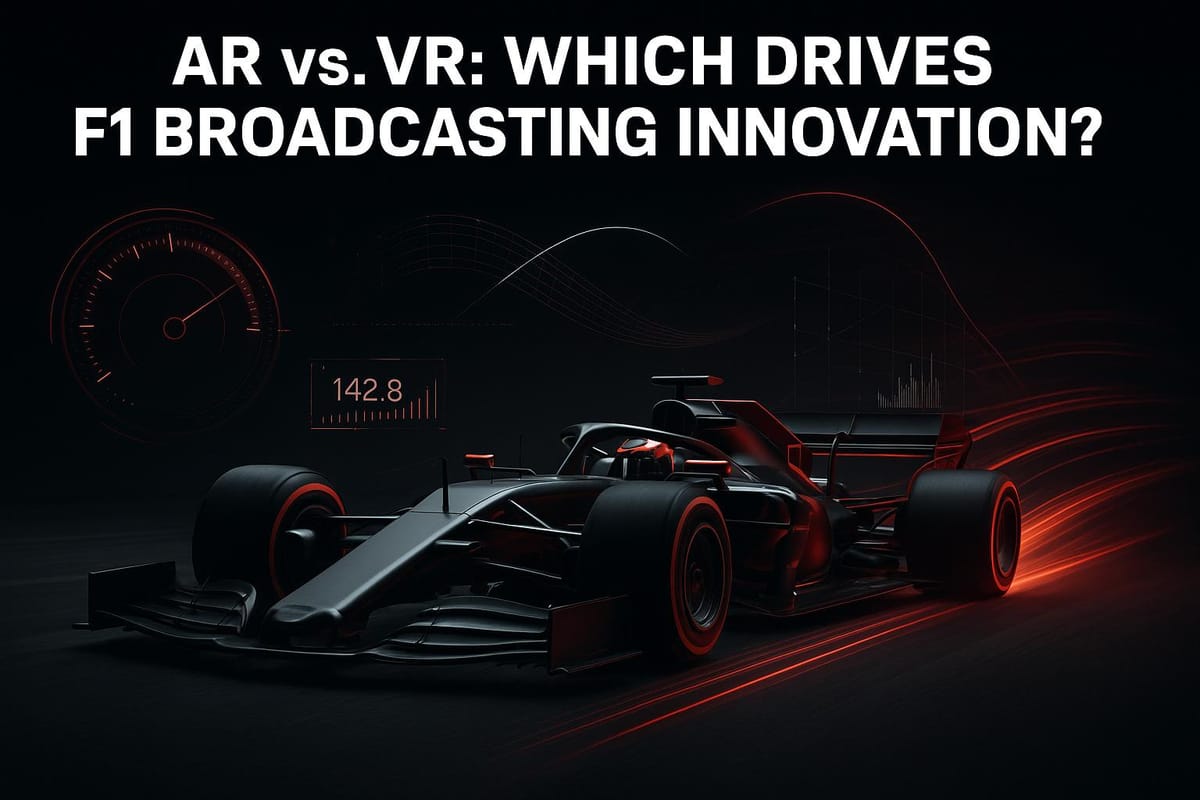
Formula One broadcasting is evolving with AR (Augmented Reality) and VR (Virtual Reality) reshaping how fans experience the sport. AR adds real-time data overlays to live footage, offering instant insights like driver stats and telemetry. VR immerses viewers in 360° environments, simulating cockpit views or trackside perspectives. Both technologies cater to different fan needs:
- AR: Ideal for live broadcasts with large audiences, showing race data without disrupting the action.
- VR: Best for immersive experiences, like training simulations or premium fan engagement.
Quick Comparison
| Factor | AR | VR |
|---|---|---|
| Accessibility | Works on TVs, phones, tablets | Requires headsets |
| Immersion Level | Moderate (data overlays) | High (360° experience) |
| Data Integration | Excellent (real-time telemetry) | Limited |
| Scalability | Reaches millions | Limited to headset users |
| Production Cost | Moderate | High |
| User Comfort | High | Variable (motion sickness risk) |
AR enhances broadcasts for mass audiences, while VR creates niche, immersive experiences. The future lies in combining both, offering fans personalized and interactive ways to enjoy F1.
F1 Like Never Before: Apple Vision Pro Takes You Trackside!
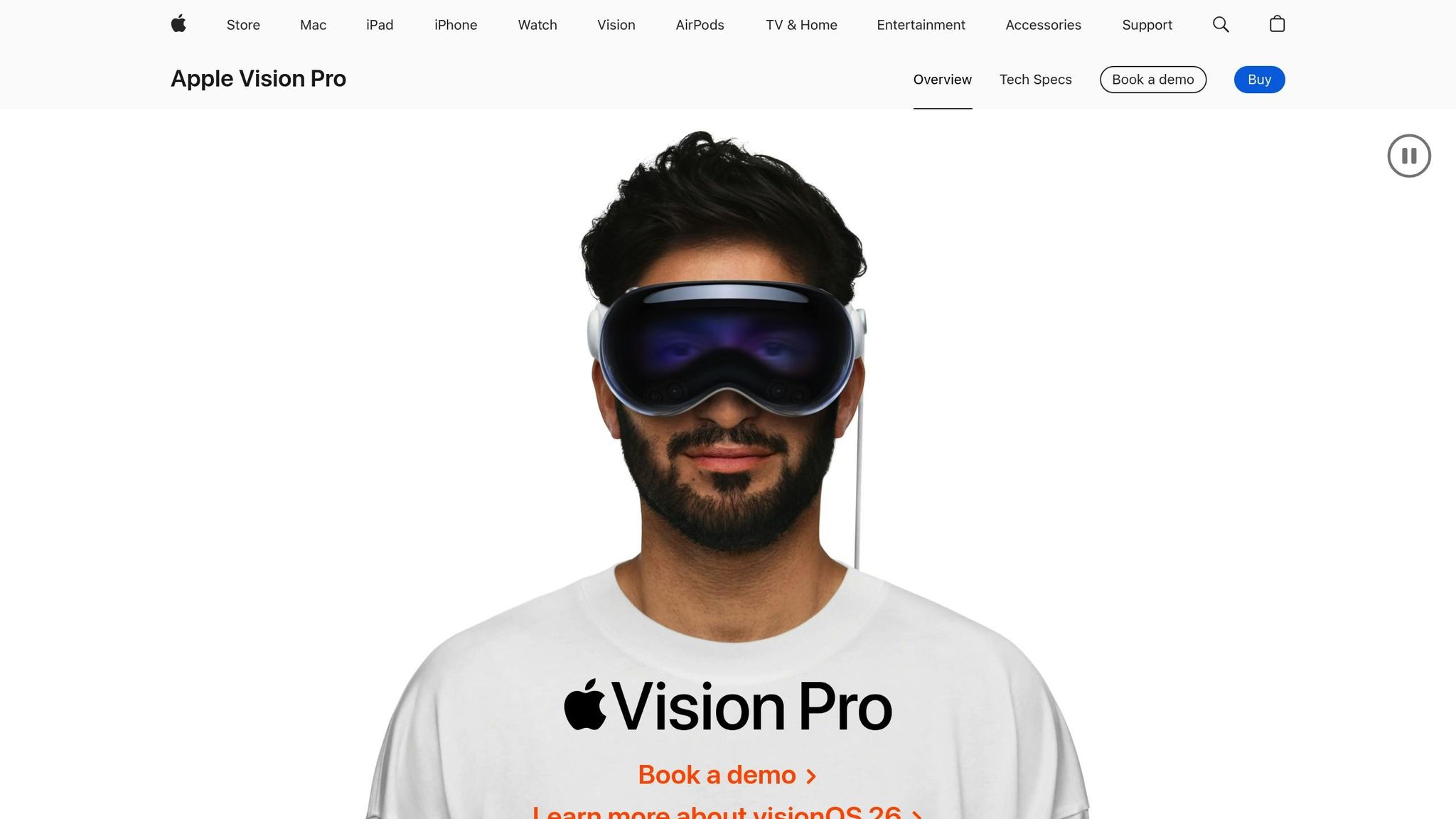
Augmented Reality: Adding Data to Live F1 Broadcasts
Augmented reality (AR) is changing the way we experience Formula One races by layering real-time telemetry data over live footage. Unlike virtual reality, which creates an entirely immersive environment, AR keeps the authentic race atmosphere intact while delivering key technical insights directly to viewers.
How AR is Used in F1 Coverage
During F1 broadcasts, live telemetry data - like engine stats and brake temperatures - appears directly on the race footage. This is all managed remotely by the F1 Media and Technology Centre (MTC) at Biggin Hill, which oversees AR tracking and RF control. Their cutting-edge setup ensures that AR seamlessly integrates with live coverage, enriching the viewing experience with real-time insights.
How AR Helps Viewers
AR simplifies complex race data for fans by overlaying crucial telemetry information right onto the live broadcast. This means viewers can keep up with technical metrics like car performance without losing sight of the on-track action. It’s a perfect blend of data and entertainment, making the sport more engaging and accessible.
Technical Setup for AR in F1
The technology behind AR in Formula One broadcasting is built on entirely IP-based workflows that integrate smoothly with production systems. New cameras and vision mixers operate over IP networks, ensuring real-time data flows seamlessly into the broadcast. Using SMPTE 2 standards, AR graphics are distributed effortlessly across various platforms.
Telemetry from race cars feeds directly into these AR graphics, synchronized precisely with broadcast equipment. The production control room workflows are designed to embed AR into the live feed without a hitch. These advancements not only streamline the production process but also make the broadcast more dynamic, keeping fans deeply connected to the action.
Virtual Reality: Putting Fans Inside the Race
Virtual reality (VR) is changing how Formula One is broadcast by offering immersive experiences that bring fans closer to the action. Whether it's feeling like you're sitting in the cockpit or standing trackside, VR creates fully digital environments that pull viewers into the heart of the race. This complements augmented reality (AR), which enhances broadcasts with real-time data overlays, giving fans even more ways to engage.
How VR Enhances F1 Broadcasting
VR provides 360-degree perspectives that traditional cameras simply can't match. Imagine watching a race as if you're in the driver's seat, feeling every twist and turn of the track. Or picture yourself standing at an iconic curve, seeing the cars roar past from a unique vantage point. These experiences make the races feel more dynamic and personal, offering fans a level of immersion that was previously impossible.
Beyond the Fans: VR's Role for Teams and Drivers
VR isn't just about thrilling the audience - it’s also a powerful tool for F1 teams. Many teams use VR to create highly accurate digital versions of circuits, helping drivers prepare for races without ever touching the asphalt. This tech allows drivers to build a mental roadmap of each track, ensuring they’re ready for every corner and straightaway.
Drivers can also practice under simulated conditions that would be too risky or impractical in real life. Scenarios like wet tracks, poor visibility, or varying fuel loads can all be recreated in VR. It’s a cost-effective way to refine skills, test setups, and get immediate feedback on performance adjustments.
Challenges Holding Back VR in F1
Despite its potential, VR adoption in Formula One comes with hurdles. The high cost of VR hardware makes it less accessible and increases production expenses. Additionally, some fans experience motion sickness, eye strain, or discomfort due to the sensory overload VR can cause.
Technical issues also pose a problem. Limitations in graphics quality, latency, and occasional performance glitches can disrupt the immersive experience. On top of that, VR broadcasting requires specialized workflows and equipment, adding to the complexity of production. These challenges make widespread VR implementation a work in progress for the sport.
AR vs. VR: Direct Comparison
When it comes to Formula One broadcasting, augmented reality (AR) and virtual reality (VR) each bring their own strengths and challenges to the table. Knowing how they differ helps broadcasters and teams make informed decisions about which technology fits their goals. Here's a breakdown of the key factors that influence the choice between AR and VR in F1 broadcasting.
Comparison Table: AR vs. VR for F1
| Factor | Augmented Reality (AR) | Virtual Reality (VR) |
|---|---|---|
| Accessibility | High – works on standard TVs, phones, tablets | Low – requires specialized headsets and gear |
| Immersion Level | Moderate – adds overlays to real-world views | High – offers a fully immersive 360-degree experience |
| Data Integration | Excellent – displays real-time telemetry, lap times | Limited – focuses more on visuals than data |
| Scalability | High – reaches millions via traditional broadcasts | Low – limited by individual headset use |
| Production Cost | Moderate – needs graphics systems and data feeds | High – requires costly cameras and equipment |
| User Comfort | High – no motion sickness or discomfort | Variable – some users may experience nausea |
| Technical Complexity | Moderate – integrates with current broadcast setups | High – demands new workflows and tools |
When to Use AR vs. VR in F1
The choice between AR and VR depends on the broadcast's goals and the audience's needs.
AR is ideal for live broadcasts aimed at large audiences. It enhances the viewing experience by overlaying key information - like tire choices, fuel loads, and sector times - on the screen without interrupting the action. For example, during qualifying sessions, AR can display lap time comparisons and track positions in real time, keeping millions of viewers informed and engaged.
VR, on the other hand, excels in niche, immersive experiences. It's particularly useful for driver training or circuit simulations, where teams can recreate specific scenarios like changing weather, overtaking maneuvers, or testing car setups. VR provides a controlled, cost-efficient way to prepare for races without needing physical track time.
Ultimately, the decision comes down to balancing audience size with the depth of the experience. AR is perfect for enhancing traditional broadcasts and reaching millions, while VR caters to smaller, dedicated groups looking for an unforgettable, immersive experience.
Cost is another key factor. AR builds on existing broadcast infrastructure with minimal upgrades, making it a practical choice for regular race coverage. VR, with its need for specialized cameras, workflows, and distribution systems, demands a larger investment and is typically reserved for premium or special-use cases instead of every race weekend.
Future of AR and VR in F1 Broadcasting
The future of Formula 1 broadcasting is gearing up to combine the power of augmented reality (AR) and virtual reality (VR) to create layered, immersive experiences for fans. With hardware becoming more accessible and network capabilities advancing, broadcasters are exploring how these technologies can cater to a wide range of viewer preferences, offering something for everyone.
This blending of AR and VR is poised to reshape how fans interact with the sport, making the experience more engaging and personalized.
Mixed Reality and Enhanced Fan Experiences
Mixed reality (MR) takes AR and VR to the next level, enabling fans to enjoy live races with AR overlays on one screen while diving into fully immersive VR environments on another. Imagine watching a race on your TV with real-time stats and graphics overlaid, while also strapping on a VR headset to feel like you're sitting in a virtual grandstand, complete with spatial audio that makes you feel the roar of the engines.
One exciting development is the rise of multi-screen setups. Fans can use their smartphones or tablets to access extra data layers, like live driver stats or alternative camera angles, all without interrupting the main broadcast. MR platforms are also creating virtual spaces where fans can gather, share real-time reactions, and connect with others who share their passion for racing. These shared experiences blend the depth of VR with the practical insights of AR, creating a more interactive and social way to enjoy the action on track.
Broadcasters are also working on customizable interfaces that adjust based on how fans are tuning in. For instance, someone watching on a traditional TV might see basic AR graphics, while a VR user could enjoy a fully immersive experience, complete with dynamic views and even haptic feedback that mirrors the vibrations of the race.
Emerging Trends and Developments
Artificial intelligence is stepping in to make AR and VR experiences smarter and more intuitive. By analyzing viewer habits, AI can decide the best moments to display additional information, ensuring fans get the details they want without feeling overwhelmed.
Advancements in network speeds and cloud rendering are also making a big impact. These technologies reduce latency and lessen the need for high-end hardware, meaning even entry-level VR headsets and standard smartphones can deliver impressive visuals and immersive experiences. Real-time 3D capture is another game-changer, allowing broadcasters to create lifelike digital models of drivers, cars, and even track elements during live events. These models can be seamlessly integrated into AR and VR environments, adding a new layer of realism to the broadcast.
Challenges and Opportunities Ahead
Despite all the progress, there are still hurdles to overcome. Infrastructure limitations and inconsistent access to high-speed internet remain significant challenges. To tackle this, broadcasters are developing adaptive streaming technologies to maintain high-quality viewing experiences, even under less-than-ideal network conditions.
Another obstacle is the cost and complexity of creating high-quality AR and VR content. Specialized skills and equipment are needed, which can be a barrier for some broadcast teams. However, these challenges also present opportunities. Premium AR and VR experiences, like behind-the-scenes content or interactive features, could open up new revenue streams. Collaborations with tech companies are already paving the way for innovations that could further enhance the viewing experience.
Interestingly, the tools for creating immersive content are becoming more accessible. This shift could allow smaller production teams to experiment with AR and VR, potentially broadening the adoption of these technologies not just in Formula 1 but across other sports as well.
The road ahead is filled with both challenges and possibilities, but one thing is clear: AR and VR are set to transform how fans experience Formula 1, making it more immersive, interactive, and engaging than ever before.
Conclusion: AR, VR, and the Future of F1 Broadcasting
AR and VR are transforming how fans experience Formula 1, offering a mix of real-time enhancements and immersive storytelling. AR brings live broadcasts to life with interactive graphics and real-time data overlays, while VR creates entirely immersive environments, putting viewers right in the middle of the action. Together, these technologies are setting the stage for a new era of motorsport entertainment.
One standout example of this evolution is Datu YogaBrata's "Virtual Trackside Experience", which won the 2016 F1 Connectivity Innovation Prize. This project combined live 360° visuals with AR overlays to provide detailed data insights. Lewis Hamilton himself applauded the innovation, saying:
"The winning solution from Datu YogaBrata gives us a glimpse of what the future of F1 could look like - and how we will be able to share so much more of our race weekend at the track with people at home. I would love it as a fan!"
These advancements cater to a wide range of fans. Casual viewers benefit from AR-enhanced broadcasts that make the races more engaging, while dedicated enthusiasts can dive into VR-powered experiences with gamified elements, such as uncovering hidden features or additional data.
As F1 attracts a global audience that thrives on technology, broadcasters face the challenge - and opportunity - of merging AR and VR seamlessly. The future of F1 broadcasting will revolve around creating personalized, interactive experiences that bring fans closer to the thrill of the race.
FAQs
How do augmented reality (AR) and virtual reality (VR) improve the Formula 1 viewing experience?
Augmented reality (AR) and virtual reality (VR) are changing how fans experience Formula 1, making broadcasts more immersive and interactive than ever. With VR, fans can feel like they're sitting in the driver’s seat or strolling through the paddock, offering a thrilling sense of presence that brings them closer to the action. On the other hand, AR enhances live broadcasts by overlaying real-time data - like driver stats, lap times, and telemetry - right onto the screen, making it easier to follow the race's fast-paced dynamics.
These tools don’t just make watching Formula 1 more exciting; they also offer a closer look at the sport's technical and strategic layers, showcasing its dedication to pushing the boundaries of technology.
What challenges limit the adoption of VR in Formula 1 broadcasting, and how can they be addressed?
The integration of virtual reality (VR) into Formula 1 broadcasting isn’t without its challenges. High equipment and infrastructure costs, technical concerns like motion sickness and eye strain, and the demand for substantial long-term investments limit its accessibility for both broadcasters and fans.
Addressing these obstacles will require a focus on creating more affordable, easy-to-use VR technology while enhancing the overall user experience to reduce discomfort. Improvements in hardware and software, coupled with a broader range of content, could pave the way for VR to become a more practical and immersive option for F1 broadcasting down the line.
How could AR and VR technologies transform F1 broadcasting and enhance fan experiences?
The integration of augmented reality (AR) and virtual reality (VR) is set to transform how Formula 1 is broadcast and how fans interact with the sport. With AR, live races can come alive like never before - imagine seeing real-time stats, interactive graphics, or even choosing your own camera angles, all overlaid seamlessly on your screen. It makes the viewing experience more engaging and interactive.
On the other hand, VR takes immersion to a whole new level. Fans can virtually attend races, feel the adrenaline of driving from a first-person perspective, or even wander through the paddock as if they were there in person. It's a game-changer for bringing fans closer to the action.
Beyond enhancing the fan experience, these technologies open doors for new revenue streams like virtual merchandise and sponsorships, ensuring Formula 1 continues to lead the charge in modern sports broadcasting.


